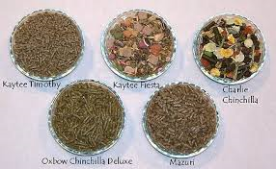As a chinchilla owner, I’ve come to realize feeding your chinchilla is way more complicated then it seems like in the beginning. When I first purchased my chinchilla I thought that all I had to do was go to Petco and find the bag labeled chinchilla food and my little guy would be taken care of. Of course, you can still do this, but I find your wallet and your chinchillas health will be much more great full if you do some more research on the subject. After a lot of digging around I’ve found the best food for both my chins and my wallet, and I’m hoping I can save someone hours of research by writing this.
Avoid Mixed Foods: These are foods like Charlie chinchilla or kaytee fiesta (listed above). While mixed foods claim to meet all of the chinchillas dietary requirements, this is only true if they eat every last morsel and if all the mixed pieces are dispersed equally, which is impossible when they’re all in the same bag. Almost every chinchilla will only pick out what they like (the junk food 99% of the time) and leave the rest, or throw it out of the bowl. Mixed foods like these are known to cause a shorter life span, diabetes, and even bladder infections. I do occasionally buy mixed foods like Charlie chinchilla and feed it to my chins as an occasional treat, but not as their main source of food.
Timothy vs. Alfalfa: This seems to be a big debate between chinchilla breeders and owners, and through research and experience this is what I’ve concluded. Alfalfa Hay should not be given to chinchillas over 6 months, it can cause obesity, bladder infections, and all kinds of problems. BUT, alfalfa based pellets are fine because they don’t consume as many pellets as hay. It is said that the ideal diet is timothy hay with alfalfa pellets. Timothy pellets or hay are completely safe and are not known to cause any health complications and I personally stick with these to be safe.
Details To Look At: A healthy chinchilla diet should contain 16-20% protein, 18-20% fiber, and about 2-5% fat. This is the most important factor to look at when deciding on a food! It does not matter if the fat percentage is lower, but fiber and protein must be between those percentages or you’re setting your chinchilla up for health complications or a shorter life span.
Feeding Rabbit Food?: A lot of people throw up their arms at this question, fully prepared to tell you how delicate a chinchilla’s digestive system is and that it should not be jeopardized with other species foods. They are completely right to be weary of feeding a chinchilla rabbit food. BUT, a select few are completely safe and actually more healthy and cost effective to feed then most commercial chinchilla foods. As long as they meet the percentages listed above, they are probably safe to use.
Here are some of the foods I’ve found to be safe and cost effective:
1.Tradition® Chinchilla Pellets
2. PANR
3. Purina Rabbit Chow Complete Advantage
4. Oxbow Essentials Chinchillas Delux
5. Purina Mazuri

